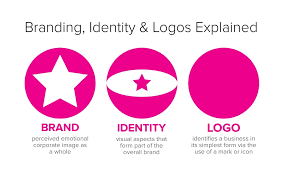
Logos and brand identity are often considered to be the same thing, but they are not. A brand’s logo is the company’s emblem of pride and reputation, while a company’s brand identity consists of more than just their logo. Brand Identity And Logo Design: Do They Go Hand-In-Hand? breaks down the difference by explaining how each one is used, who uses them, why they’re important, what they do, and how they’re structured.
What is Brand Identity?
In short, brand identity is the overall image and perception a company or product has in the minds of its customers. This includes everything from the colors and fonts used on labels and advertising to the overall design of company websites.
Logo design is one important aspect of brand identity. A good logo should be recognizable and appealing, conveying the company’s personality to customers. It should also be simple and easy to create, replicating as closely as possible the look and feel of the company’s branding materials. You can find various logo design online to choose one from.
How Does a Logo Define a Company?
Logos are arguably one of the most important aspects of a company’s branding. They can be used to represent a company in a variety of different ways, and can help to define the company’s identity. In order to create a logo that effectively represents a company, it is important to consider its branding goals. Different companies will have different needs when it comes to their logos, but there are some common considerations that should always be taken into account.
One of the most important factors when it comes to designing a logo is its visibility. A logo should be able to be easily recognized by consumers, employees, and other businesses. Additionally, a logo should be easy to remember and use in marketing materials. It is also important for a logo to be updated regularly so that it reflects the latest trends and changes within the industry.
Another important consideration when it comes to logos is their design simplicity. A complex logo can be difficult for consumers and employees to understand, and can ultimately lead to confusion. In addition, a complex logo can be hard to update or change if necessary. Instead, strive for a simple design that is easy to replicate and adapt.
What are the Benefits of a Brand Identity?
A brand identity is the visual representation of a company or product. It is a set of core values, images, and symbols that identify a company or product from the competition. A well-developed brand identity can create a connection between customers and products, leading to increased sales and loyalty.
Logo design is one of the key elements of branding. A good logo design should be simple, recognizable, and consistent across all media. It should also reflect the brand identity and help communicate the company’s message to consumers.
Here are five benefits of having a well-developed brand identity:
1. Brand recognition – A well-developed brand identity will help your company stand out from the competition. Consumers will be more likely to recognize your products and services, and they’ll be more likely to recommend them to friends.
2. Increased sales – A well-designed logo can help increase sales by creating a visual connection between your product and your customers. When customers see your logo consistently across all media, they’re more likely to buy your products.
3. Increased customer loyalty – Consistent branding can lead to increased customer loyalty in the long run. Customers will be more likely to return to your store or continue using your products because they’ll be more comfortable with your brand.
4. Increased brand recognition – Consistent branding through every step of the production process can strengthen your brand and help you get the word out about your business in a cost-effective way.
5. Increased brand reputation – Successful companies have strong brands that are consistently known for their quality, so people will recognize them more often and associate them with success regardless of the name on the package or product label. Companies use branding to build recognition and loyalty among consumers, which leads to increased sales, increased customer loyalty, and increased brand recognition over time.
How to Make Your Own Logo Design ?
A logo is the visual identifier of your brand. It can be a simple design or an elaborate one, but it must be unique and recognizable. A well-designed logo reflects your brand’s personality and values. A poorly designed logo can lead to customer confusion and lost sales.
To create a logo that will stand out and reflect your brand’s identity, begin by considering the following factors:
1.Your Brand’s Personality
The first step in creating a logo is understanding your brand’s personality. What is its vibe? What are its values? How do you want customers to perceive it? Once you have a good idea of your brand’s personality, you can start to develop designs that reflect that personality.
2.Your Brand’s Appearance
Your brand’s appearance also plays a role in logo design. Do you want your logo to be bold and graphic or sleek and minimalistic? Do you want it to be traditional or modern? The answers to these questions will help you choose the right style for your logo. You can find various free logo design on the internet to choose.
3.Your Brand’s Message
Your brand’s message should always be reflected in your logo design. Is your company focused on technology? Customer service? Green products? Whatever the focus of your business, the logo should reflect it.4.Your Brand’s HistoryThe most important thing to consider when designing a logo is its history. Are you starting from scratch or have you already developed an existing logo? You will not want to go through the effort of creating a new brand logo unless you are confident that it can live up to company expectations as well as your own standards.5.Your Brand’s Personality consider how your brand personality plays into the design process. How modern or classic is it? Are you looking for an image that emphasizes confidence and professionalism or one that conveys creativity and fun? Once you know what type of image you want to convey, then the rest is easy: Just design something unique.
Tips on Creating a Professional Logos
Creating a professional logo is essential for any business, and it’s something that can often be overlooked. A well-designed logo will help your business stand out from the competition, and can also help you to build a brand identity. Here are some tips on how to create a professional logo:
1. focus on branding goals
When designing your logo, make sure that you’re focused on your branding goals. What do you want your logo to achieve? Are you looking to establish a presence online? Create a unique and memorable design that will reflect this.
2. consider the target audience
Think about who your logo is intended for. Is it for businesses of all sizes? Or are you targeting a specific industry? Once you have an idea of who your target market is, make sure that your logo design reflects this.
3. think about the look andfeel of the logo
Your logo should be able to convey the brand identity visually as well as audibly. Are you looking for a classic or modern look? Do you want a muted or bright color palette? These are all important considerations when designing your logo.
4. create an effective name and tagline
Your name and tag line are critical for communicating your brand’s identity all over again. Your company name and tagline should be short and simple, to keep things clear. What you want to avoid is a long, complicated tagline that may confuse your target audience.
5. last but not least, if you don’t have a logo, try creating one with the help of a professional designer or online logo maker. It might take time, but it could also save you much more time in the long run. You can visit Designhill website and check out the designs we have for you for the best logo.
Conclusion
When it comes to brand identity and logo design, oftentimes the two are inseparable. A great logo not only identifies a company or product, but also sets the tone for the rest of a company’s branding. On the other hand, a well-designed brand identity can help promote your logo to an even wider audience. As such, it is important that both aspects of branding are given careful consideration when designing either element of your business’s image.




